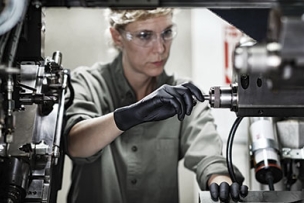Honeywell’s safety innovations protect the livelihoods of 500 million workers. With a legacy spanning over a century, Honeywell provides comprehensive PPE solutions from head-to-toe. Honeywell offers a vast of product solutions from brands you trust like Miller®, Uvex®, Howard Leight, North®, and Fibre-Metal®.
As the future of the automotive manufacturing industry continues to evolve with automation, connected technologies, AI, robotics and new ways of working, nothing can replace the human touch. The integration of advanced technologies into manufacturing facilities plays a critical role in helping workers free up their time to work like humans and demonstrate their value through creativity and problem solving to build a better future for everyone.
Robots in the automotive manufacturing industry are designed to take over repetitive motion tasks that put humans at risk of muscle strains, reducing injuries and allowing human workers to use their specialized skills for other operations. National Public Radio (NPR) echoes this sentiment in their article, Even In The Robot Age, Manufacturers Need The Human Touch.
“In general, people and robots work best together, with robots handling dangerous, monotonous jobs and precision work, while people handle tactile work, switch between tasks, make decisions — and come up with creative ideas for improving things.”
Here are three aspects of automotive manufacturing where the human touch enables manufacturers to produce a high-quality vehicle:
Quality Assurance
Quality assurance is a critical stage in automotive manufacturing. When vehicles leave automotive manufacturing facilities, their final stop is the road with drivers behind the wheel. Workers are tasked with ensuring vehicles on the assembly line are produced with consistency to meet the industry standards. Vehicles that leave the facility without proper quality checks can result in product recalls and can be dangerous for drivers.
While robots and sensors can be configured to test for imperfections, they’re limited by the parameters set within them. Workers can identify and eliminate defects using their keen attention to detail, taking note of anything that might seem out of place. They can investigate and amend as necessary using their creative problem-solving skills to fix any issue before the vehicle gets on the road.
Assembly of Complex Shapes
Even though robots have replaced many of the repetitive motion tasks on the assembly line, more complex assemblies still require the human touch. Certain aspects of automotive manufacturing require the assembly of complex shapes. With humans’ hand-eye coordination and ability to manipulate certain shapes more effectively, such as the parts attached to an engine, the human touch isn’t obsolete from the assembly line.
Problem Solving
Humans can both see and feel imperfections or potential problems in production that robots can’t. Robots rely on configurations to accomplish their goal and are limited to identifying mistakes based on how the software is set up. However, humans can look at things holistically, giving workers a distinct advantage over their mechanical counterparts to problem-solve, identify problems across multiple areas and keep production running smoothly.
NPR says it best: “Humans edge out robots at these tasks even when everything is going smoothly, but they have a particular advantage whenever things go wrong.”
Human-Centric Innovation in the Automotive Manufacturing Industry
Honeywell recognizes the importance of human-centric innovation in automotive manufacturing. It’s a value that drives the efforts of their Honeywell User Experience (HUE) team from the inception of the product development process. Their product designers take a holistic approach to creating human-centered product designs based on customer research that helps workers across industries complete their work tasks safely with minimal intrusion.









Talk to Us!
Leave a reply
Your email address will not be published. Required fields are marked *